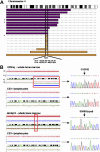Loss of heterozygosity 4q24 and TET2 mutations associated with myelodysplastic/myeloproliferative neoplasms
- PMID: 19372255
- PMCID: PMC2710933
- DOI: 10.1182/blood-2009-02-205690
Loss of heterozygosity 4q24 and TET2 mutations associated with myelodysplastic/myeloproliferative neoplasms
Abstract
Chromosomal abnormalities are frequent in myeloid malignancies, but in most cases of myelodysplasia (MDS) and myeloproliferative neoplasms (MPN), underlying pathogenic molecular lesions are unknown. We identified recurrent areas of somatic copy number-neutral loss of heterozygosity (LOH) and deletions of chromosome 4q24 in a large cohort of patients with myeloid malignancies including MDS and related mixed MDS/MPN syndromes using single nucleotide polymorphism arrays. We then investigated genes in the commonly affected area for mutations. When we sequenced TET2, we found homozygous and hemizygous mutations. Heterozygous and compound heterozygous mutations were found in patients with similar clinical phenotypes without LOH4q24. Clinical analysis showed most TET2 mutations were present in patients with MDS/MPN (58%), including CMML (6/17) or sAML (32%) evolved from MDS/MPN and typical MDS (10%), suggesting they may play a ubiquitous role in malignant evolution. TET2 mutations affected conserved domains and the N terminus. TET2 is widely expressed in hematopoietic cells but its function is unknown, and it lacks homology to other known genes. The frequency of mutations in this candidate myeloid regulatory gene suggests an important role in the pathogenesis of poor prognosis MDS/MPN and sAML and may act as a disease gene marker for these often cytogenetically normal disorders.
Figures





Similar articles
-
Novel mutations and their functional and clinical relevance in myeloproliferative neoplasms: JAK2, MPL, TET2, ASXL1, CBL, IDH and IKZF1.Leukemia. 2010 Jun;24(6):1128-38. doi: 10.1038/leu.2010.69. Epub 2010 Apr 29. Leukemia. 2010. PMID: 20428194 Free PMC article. Review.
-
Mutation in TET2 in myeloid cancers.N Engl J Med. 2009 May 28;360(22):2289-301. doi: 10.1056/NEJMoa0810069. N Engl J Med. 2009. PMID: 19474426
-
Genomic Landscape of Myelodysplastic/Myeloproliferative Neoplasms: A Multi-Central Study.Int J Mol Sci. 2024 Sep 23;25(18):10214. doi: 10.3390/ijms251810214. Int J Mol Sci. 2024. PMID: 39337700 Free PMC article.
-
Genomic aberrations of myeloproliferative and myelodysplastic/myeloproliferative neoplasms in chronic phase and during disease progression.Int J Lab Hematol. 2015 Apr;37(2):181-9. doi: 10.1111/ijlh.12257. Epub 2014 May 21. Int J Lab Hematol. 2015. PMID: 24845343
-
Clinical Applications of Chromosomal Microarray Testing in Myeloid Malignancies.Curr Hematol Malig Rep. 2020 Jun;15(3):194-202. doi: 10.1007/s11899-020-00578-1. Curr Hematol Malig Rep. 2020. PMID: 32382988 Review.
Cited by
-
Transcription factor mutations in myelodysplastic/myeloproliferative neoplasms.Haematologica. 2010 Sep;95(9):1473-80. doi: 10.3324/haematol.2010.021808. Epub 2010 Apr 26. Haematologica. 2010. PMID: 20421268 Free PMC article.
-
Novel mutations and their functional and clinical relevance in myeloproliferative neoplasms: JAK2, MPL, TET2, ASXL1, CBL, IDH and IKZF1.Leukemia. 2010 Jun;24(6):1128-38. doi: 10.1038/leu.2010.69. Epub 2010 Apr 29. Leukemia. 2010. PMID: 20428194 Free PMC article. Review.
-
TET2 gene is not deleted in chronic myelomonocytic leukemia: a FISH retrospective study.Haematologica. 2010 Oct;95(10):1798-800. doi: 10.3324/haematol.2010.027920. Epub 2010 Jun 30. Haematologica. 2010. PMID: 20595094 Free PMC article. No abstract available.
-
Mutational spectrum analysis of chronic myelomonocytic leukemia includes genes associated with epigenetic regulation: UTX, EZH2, and DNMT3A.Blood. 2011 Oct 6;118(14):3932-41. doi: 10.1182/blood-2010-10-311019. Epub 2011 Aug 9. Blood. 2011. PMID: 21828135 Free PMC article.
-
Spectrum of mutations in RARS-T patients includes TET2 and ASXL1 mutations.Leuk Res. 2010 Aug;34(8):969-73. doi: 10.1016/j.leukres.2010.02.033. Epub 2010 Mar 23. Leuk Res. 2010. PMID: 20334914 Free PMC article.
References
-
- Robinson WP. Mechanisms leading to uniparental disomy and their clinical consequences. Bioessays. 2000;22:452–459. - PubMed
-
- Kralovics R, Guan Y, Prchal JT. Acquired uniparental disomy of chromosome 9p is a frequent stem cell defect in polycythemia vera. Exp Hematol. 2002;30:229–236. - PubMed
-
- Kralovics R, Passamonti F, Buser AS, et al. A gain-of-function mutation of JAK2 in myeloproliferative disorders. N Engl J Med. 2005;352:1779–1790. - PubMed
-
- Levine RL, Wadleigh M, Cools J, et al. Activating mutation in the tyrosine kinase JAK2 in polycythemia vera, essential thrombocythemia, and myeloid metaplasia with myelofibrosis. Cancer Cell. 2005;7:387–397. - PubMed
Publication types
MeSH terms
Substances
Grants and funding
LinkOut - more resources
Full Text Sources
Other Literature Sources
Medical
Molecular Biology Databases
Research Materials
Miscellaneous

